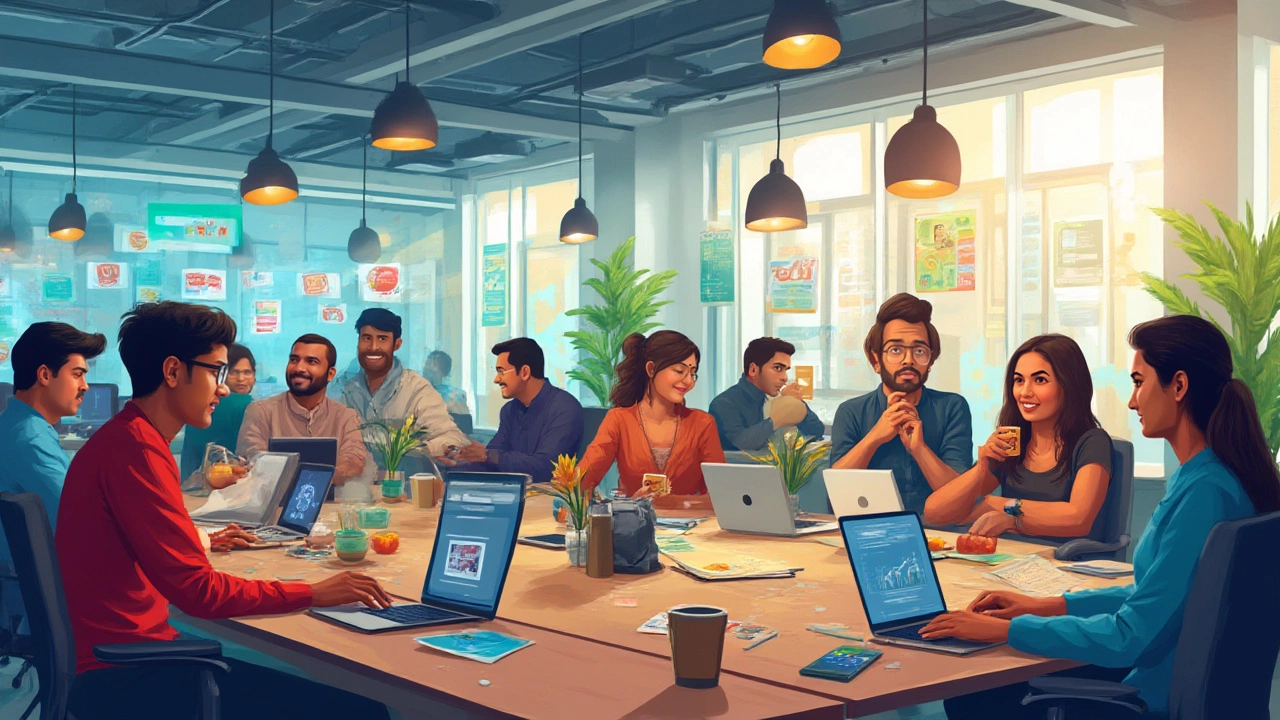India’s startup scene isn’t just booming—it’s turbocharged. Fresh founders appear every week, millions of new customers are finding their way online, and unicorns are popping up faster than you can scroll your feed.
Here’s a curveball: at least 20,000 startups in India survived between 2017 and 2022, but less than a fifth broke even by year three. That number looks scary until you remember something simple—most people start in the wrong niche or copy bad ideas. This guide isn’t about pointing to some mysterious billion-dollar idea. It’s about showing you how to actually pick a startup that gives you a fighting chance. I’ll talk about where the money is flowing, which business models have legs, and how you should be thinking about demand, skills, and scalability. Let’s cut the fluff and get straight to strategies that work in this market.
Big Trends Shaping Startup Success Right Now
If you’re hunting for the best startup to start in 2025, ignoring loud trends is like taking the field without checking the weather forecast—risky and unnecessary. Let’s talk big winds that are shaping the playing field.
First, numbers are on your side. About 850 million people in India are active internet users as of 2025. So digital-first businesses—from small-scale e-learning startups to massive e-commerce engines—have basically unlimited room to grow. If you’re online, you’re in the game.
Next, there’s a social push toward health, sustainability, and convenience. Smart founders are exploiting this in a big way: green packaging startups, health tracking gadgets, and quick commerce platforms are drawing big investors. The funding for sustainable startups crossed $12 billion in 2024, up from barely $2 billion in 2020. Plant-based protein brands, for example, are doubling revenue year on year in major cities.
Tier 2 and tier 3 cities, the kind people used to overlook for anything tech, are now part of the startup mainstream. Broadband is everywhere, smartphone penetration passed 70%, and people in places like Indore or Coimbatore are as likely to shop, learn, or bank digitally as in Mumbai. SaaS companies started with US clients are now finding Indian B2B is bigger than expected, especially for small retailers needing inventory, billing, and GST support.
But what about investors? No point picking a lane no one’s willing to back. The data speaks: over 1,400 Indian startups got early-stage funding above $1M in the past year, and anything that uses AI, fintech, or direct-to-consumer brands gets far more interest than education or delivery. A record 79 Indian startups became unicorns between 2021 and 2025. Tech-enabled business is what serious investors are looking for, but “tech enabled” doesn’t mean you need to be Elon Musk—it means using common tools, not building rockets.
Another juicy angle: the government is throwing its weight behind entrepreneurship. GST reforms, easier company registration, and even direct seed grants for ‘priority’ businesses (think agri-tech, health, logistics, clean energy) are on the table.
Here’s a table showing where startups have ranked by funding and user growth in India over the last three years:
| Startup Sector | Avg. Annual Funding Growth (2022-2024) | User Growth Rate |
|---|---|---|
| Direct-to-Consumer Brands | 33% | 21% |
| Fintech | 40% | 25% |
| Health & Wellness Tech | 38% | 18% |
| AgriTech | 29% | 16% |
| SaaS | 42% | 23% |
| Quick Commerce | 36% | 32% |
| EdTech | 13% | 9% (declining) |
Trends aren’t gospel, but they’re a warning sign. Ignore them and you’re crossing the street blindfolded.
Identifying Hot and Profitable Startup Opportunities
So what actually makes a startup idea hot and profitable in India, as of right now? It’s not just originality or following the herd.
If you want a checklist, it looks a bit like this: proof of growing demand, scalability (local and ideally global), simple regulatory hurdles, and an obvious pain point that isn’t solved well by big players. Let’s get specific.
- Fintech Startups: Even with UPI and payment apps on every phone, India’s small businesses and gig workers are still hungry for better tools: digital bookkeeping, tax management, low-cost lending, ID verification, or wealth management tailored for the lower middle class. Market research shows these sub-niches still have more than 200 million potential users.
- Direct-to-Consumer (D2C) Brands: Think smart snack foods, organic beauty, home-grown coffee labels, natural cleaning products. Even socks and shoes are booming, so long as you build a brand with personality. Ship directly, own your customer data, and skip the middleman. The D2C e-commerce market is now over $60 billion, up from $30 billion in 2020.
- Health & Wellness Tech: Tired of people talking telemedicine? The real action is in health monitoring (apps, wearables), at-home fitness, online therapy, and accessible mental health solutions. Simple apps with regional language support are getting millions in rural downloads.
- SaaS for Indian SMEs: Offer cloud software that helps small shops digitize their supply, selling, tax filing, HR, or even WhatsApp marketing. It doesn’t sound sexy, but margins are high and outreach is digital. Most Indian SaaS unicorns grew quietly by serving odd gaps in SME management.
- Green/AgriTech: Startups reducing food waste, boosting yield with AI, or building sustainable local logistics are getting traction. Post-harvest cold storage solutions, agri-finance apps, and last-mile food transport have investor attention.
Look at your skills before you fall for the hype. Can you code, sell, build supply chains, or negotiate with vendors? Do you know enough about a sector to solve real pain? For instance, a successful vegan snacks startup in Pune scaled early by selling directly at gyms, listening to feedback, then shifting to e-commerce later. Hard data: food tech consumption jumped more than 50% in just two years, and organic snacks now make up over 12% of all online food sales.
Don’t start big if you’re new. Run pilot projects, gather paying customers, and then double down on what works. That’s what founders at yogurt brand Epigamia, mattress startup Wakefit, and packing-solution Bizongo did—they hustled for real user feedback in their first six months instead of spending on shiny offices.

Common Traps New Startup Founders Fall Into
Here’s the not-so-secret part: half of what you read on startup forums is noise. People are quick to copy ideas they don’t really understand or raise funding before they test the market. There’s a graveyard of failed startups who focused on the wrong priorities.
The most dangerous trap: believing passion beats demand. The hard truth is, it doesn’t. Best-selling Indian startups rarely came from wild “eureka” moments—they came from spotting ugly, ignored, daily problems. Don’t fix things nobody cares about. Focus on products or services that offer massive relief to a loud problem.
Another classic mistake—a rush for scale before ironing out logistics. Zomato and Swiggy didn’t go national until they’d locked down order fulfillment and payments in a handful of cities. If you try to serve all of India from day one, you’re more likely to run out of cash and patience. Digital-first businesses can still flop if you can’t handle spikes in customers or back-end failures.
Chasing glamorous tech stacks is also a rookie error. Do you really need the latest AI-powered chatbot if your app is meant to help vegetable vendors print GST bills? Unless the tech is core to your solution, keep it minimal early on. Razorpay, despite being in fintech, started out by supporting just the most basic payment flows and grew from there. You can always add more features—don’t overwhelm yourself in the first six months.
Forgetting about regulations is a fast track to shutdowns. In fintech, health, food, or logistics, rules change often and can doom a young company. You’d be surprised how many promising health-tech apps got blocked by not following simple data privacy rules or not registering with the right authorities. Check compliance needs before you write a single line of code.
Trying to do everything yourself (or with friends) is a brand-new founder’s Achilles heel. The best founders quickly find sharp people for what they don’t know—accounts, digital marketing, legal registration—so they don’t burn out on admin.
How to Choose the Best Startup for Your Situation
Picking the “best” startup is deeply personal, but you can be strategic about it. Here’s how to make that call without guessing.
- Audit Your Skills and Network: What do you bring to the table? Technical chops, killer sales instincts, a family background in supply chains, or even just hustle? If your cousin runs a warehouse or your college roommate is a legal whiz, that’s a hidden weapon most outsiders don’t have. Real founders use personal connections as a growth hack.
- Match Demand with Your Superpowers: Scan local WhatsApp and Facebook groups to see what’s missing in your city or network. Start small—find a gap where you can meaningfully solve something using your skills. Don’t look for markets, look for frustrations.
- Check Scalability and Recurring Revenue: Businesses that grow with every sale and lead to monthly repeat purchases are gold. Subscription-based SaaS, D2C consumables, digital education with longer courses are more stable than one-time product sales.
- Test and Validate: Before building a fancy app or dumping cash into inventory, make a simple online demo or MVP and see if people actually pay for it. If they only ‘like’ your idea but don’t buy, move on. This experiment phase should last 2-4 months max. Google Sheets, Instagram, and WhatsApp are underrated startup test labs.
- Understand Regulations Early: Visit the Startup India portal, check licensing and registration specifics, and consider GST impact if your product or service is taxable. It’s easy to get blindsided six months in if you skip the legal basics.
- Look at Funding Pathways: Bootstrapping works for low-investment services, D2C brands, and SaaS. If your business needs significant up-front capital, map local angel investor or government schemes—lots are now focused on women founders, green tech, and city-specific innovation.
- Study Margins and LTV: Low margin startups (food delivery, pure reselling) are tough unless you scale fast. Calculate your “lifetime value” and acquisition cost—if you spend more to get a customer than you earn from them, pivot sooner.
I talked to three startup founders in Bengaluru earlier this year. One runs a no-frills SaaS for inventory management aimed at kirana stores. He started with just 60 users and within 18 months grabbed more than 7,000, with minimal marketing. His secret? He actually spent weeks watching how these shops worked and asked them about pain points, instead of building features based on tech trends. Another friend made hand-crafted pet accessories and sold them on Instagram. She only scaled up when monthly orders crossed 150 and even then, didn’t hire full-time help right away. Build methodically—don’t rush scale because of FOMO.

Real-World Startup Ideas That Actually Work in India 2025
Ready to skip theory? These ideas are on fire right now, based on data—not just social media hype. They’re battle-tested, scalable, and—if executed right—can turn into full-time businesses within a year or two. Pick the one that best matches your skill set:
- Micro SaaS for SMEs: Build subscription-based tools for small shop owners—billing, inventory tracking, WhatsApp invoicing. A 2025 survey showed that 64% of Indian small businesses still use pen and paper for orders—massive room to digitize.
- Personal Wellness and Fitness Products: Niche wellness wearables, home workout accessories (think resistance bands for seniors), or even healthy snack packs. Health-focused D2C saw 40%+ sales jump post-pandemic and hasn’t slowed down.
- Ethical Fashion and Upcycled Clothing Brands: Young consumers pay extra for unique designs and sustainability claims. Indian upcycled clothing startups often double their margins by selling limited runs on niche online platforms.
- Fintech for Underserved Segments: Digital lending for gig workers, micro-insurance products, or rural credit scoring platforms. UPI transaction volume hit 17 billion in June 2025, but many workers still can’t get loans or bank accounts easily.
- AgriTech Supply Chain Solutions: Mobile apps linking farmers directly to local restaurants, cold-storage-as-a-service, or farm produce logistics. These can land grant funding and huge customer stickiness with the right partnerships.
- Regional Language Content Platforms: News summarization, job alerts, AI-powered spouse matchmaking, or job apps for blue-collar workers, but all in regional scripts. Indian language users now make up 75% of all new internet users every year.
Each new startup batch at incubators like Y Combinator and Sequoia’s Surge has examples of these models, and nearly all their rising stars focus on Indian specifics—regional language support, payments flexibility, cash-first customers, and family-driven buying decisions.
The best startup isn’t the trendiest—it’s the one rooted in a real Indian problem, led by someone willing to listen, adapt, and scale smartly. So start small, iterate fast, and stay hungry for feedback.


